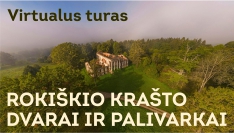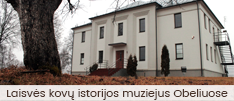Museum history
The beginnings of Rokiškis Regional Museum date back to 1933, when school inspector Juozas Ruseckas, schoolteacher Petras Bliūdžius, the town’s burgomaster Julijonas Malevičius and other enthusiasts assembled at the Society for Regional Studies and established the Museum of Regional Studies. The RokiškisRegionalMuseum has an interesting museological history as for nearly half a century it has been settled in Rokiškis Manor House that had belonged to several generations of Tyzenhauz Counts and the Psezdziecky family, known for cultural and scientific activity, collections and patronage.
The first museum spaces were two rooms in the county library. From 1935, the museum established itself in the town centre, in the present-day Rokiškis District Municipality Juozas Keliuotis Public Library. The first collections were composed of objects of museological value that were accumulated by the county’s teachers and students, as well as artefacts brought over from the Rokiškis Secondary School museum. In 1938, when the museum started to receive financial support from the Ministry of Education, more sizeable ethnographic objects were added to the collection, the opportunity arose to acquire a few artefacts of greater value. In 1939 the museum’s collection consisted of 1046 objects of museological value.
With the arrival of Soviet rule, the owners of Rokiškis Manor House fled Lithuania, and the remaining artistic valuables came under threat. It was then that P. Bliūdžius and the town’s burgomaster Vladas Paukšta began to see to it that they would not perish. In 1940, the museum was relocated into the manor house and declared a state institution. However, this joy was short-lived because in December of 1940 a regiment of the Red Army settled into the manor, the commanders of which refused to cooperate with P. Bliūdžius in order to preserve the collections of artefacts.
Director of the Museum (1947-1953)Alfonsas Krasauskas by the Museum, Set in a Wooden Chapel in 1950
The war began. The Nazi administration completely restricted the activity of the museum. Artefact collecting work grinded to a halt. Many nationalised art objects were never brought back. Many artefacts, especially those that had practical functions, were looted by private individuals. Due to the uncertain safety of the works of art, many of the museum’s most valuable paintings and prints were transferred to the Kaunas Museum of Culture in 1941. The Rokiškis museum was once more renamed as the Rokiškis Museum of Regional Studies. Juozas Simanavičius, the secondary school drawing teacher, became the director of the museum. In 1942, at the demand of Hitler’s government, the museum was forced to move out of the manor house. Artefacts were stored in the secondary spaces of the manor house. After the war, museum activity commenced once more, the use of the principal rooms of Rokiškis Manor House was returned. In 1947, under the leadership of director Alfonsas Krasauskas, expositions were installed and opened to the public, an extensive collection of prints amassed by collector Povilas Gasiūnas was brought to the museum. In 1948, use of the manor house was awarded to Rokiškis Collective Farm and the museum was once again relocated. This time it was moved to a small unheated wooden church in Vytautas street.
In 1952, the museum, along with other cultural institutions, was returned the use of the manor house. Expositions of archaeology, folk art, natural science and ethnography were opened, and a few years later the first exposition of the Soviet period was set up.
A new organisational and creative chapter (1957-1966) in the history of the museum is associated with museum director Stasys Daunys. Under his leadership, the institution’s activity became much more intense. In the 1958-1959 period, archaeological excavations were conducted at Juodonys castle mound, a peasant’s homestead was transferred to the territory of the museum and a section dedicated to folk domestic life was set up in the manor park. The Zarasai Museum became a branch of the Rokiškis museum, and a folk art exposition was set up in Stelmužė Church. S. Daunys discovered Lionginas Šepka, an incredible wood carver, whose work was brought to the museum.

In 1966, S. Daunys left the museum to work in Rumšiškės, and Algimantas Kvartūnas was appointed as director by the Ministry of Culture. The museum expanded, as did its collections and expositions. In 1970, a folk art exposition was opened, the following year − an exposition of Lionginas Šepkus’ wood carvings, in the period of 1975-1980 − a historical exposition. In 1979, the museum was granted ownership of two outbuildings, formerly the quarters of employees hired to work at the manor house (kumetynai). The other cultural institutions that had been established in the manor house were accommodated in the new buildings, leaving the museum as the sole proprietor of the manor house ensemble. Besides managing museum activity, the director had to take care of the repair and restoration of the manor buildings, as well as the maintenance of the manor park. The director left in 1980. In the last few decades, the long line of male museum directors was replaced by female leadership: Ona Mackevičienė (1980-1985), Marijona Mieliauskienė (1985-1987), Olga Grumbinienė (1987-1989), and Nijolė Šniokienė from 1989. The manor ensemble buildings, walls and park underwent many years of restoration. In 1987, with the transformation of the heating system, all expositions were dismantled. Because the restoration of the museum was funded solely by the district municipality, work was long-drawn-out. The situation changed when in 1996 museum restoration started to receive additional funding from the Cultural Heritage Department of Lithuania. The ensemble changed rapidly: the central manor house and the north facades of the servants’ quarters were restored, roofs were laid anew, the facade square of the park was cleared up, pathways were built, the great hall of the manor house restored, and new plumbing installed.



The opening of the great hall in April of 1997 was a long-awaited celebration not only for museum workers, but for all Rokiškis residents. More than four decades later (since it was adapted as a district cultural centre in 1954), the manor house was allowed to exude its former glory once again, becoming the representative location of the town. This was a great opportunity for museum workers to organise various events, invite visitors to concerts of chamber music, literary evenings and other gatherings. The restoration of the hall was the second stage of the manor house interior reconstruction as, in 1984, the Count’s dining room was opened after restoration, receiving a lot of public interest and encouraging museum workers to create further plans for a more extensive exposition dedicated to manor house culture and history. Currently, the museum houses over 90 thousand exhibits. The unique history and culture of the Rokiškis Region is preserved here: countless archaeological finds, old books, documents and prints, coins and banknotes from various ages, visual and applied art pieces representing manor house culture, a valuable collection of the Counts’ clothing, manor house archival material, photographs, old and new folk art collections with the exceptional works of the 20th century’s most famous Lithuanian wood carver, Lionginas Šepka, and the only collection of nativity sculptures in the country. The museum conducts research, publishing, educational and expositional activity, as well as organising events and festivities. In 2012, the RokiškisRegionalMuseum was chosen as the Museum of the Year. It was selected by experts as one of Lithuania’s 20 best museums, receiving the most votes by online news site delfi.lt readers.
ROKIŠKIS REGIONAL MUSEUM
Legal Form: Municipal budgetary institution;
Address: Tyzenhauzų g. 5, LT-42115, Rokiškis;
Company code: 190263920;
Tel. +370 458 52835;
E-mail: muziejus@rokiskyje.lt
Data is collected and stored at the Register of Legal Entities.
WORKING HOURS
Monday – Thursday 8.00 – 17.00 h.
Friday 8.00 val. – 15.45 h.
Lunch 12.00 val. – 12.45 h.
Before the holidays we work 1 hour shorter




















































